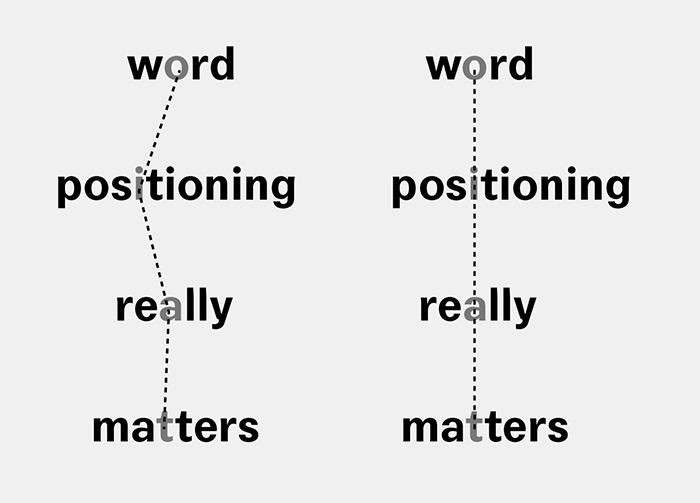Speed reading applications such as Spritz (2014) isolate individual words from bodies of text and display them sequentially, often with the middle letter highlighted. Known as Rapid Serial Visual Presentation (RSVP), its proponents suggest it can accelerate reading speed from the average of 100-200 words per minute, to over 1000. This is principally achieved by the visual system reducing the number of saccades involved in “normal” reading. When reading a word among many other words, for example a line of text, you are reading both backwards and forwards, scanning ahead for words within your parafoveal vision, and back again. The speed reading app Spritz declares on its website that:
You’ll find that you will be able to inhale content when you regain the efficiencies associated with not moving your eyes to read. And you will no longer move your eyes in unnatural ways.11 Spritz, “How it works,” 2014, http://b-o.fr/spritz 
This is a new natural then, where we inhale content, and exhale who knows what. Not so much vapourware, as vaping words. But this invocation of old “unnatural ways” and new physical and neuronal processes is both the most radical conceptual side effect of this esoteric technology, and the rhetoric that surrounds it. […] In fact, speed reading as a term, application and a commercial enterprise, in the case of Spritz and others like it, has essentially appropriated and redirected the science of RSVP toward their own commercial, and one could say accelerationist ends.22 Accelerationism is a term coined by Benjamin Noys, to refer to the political ideology of embracing capitalism’s tendency towards destructive speed. In recent years, there has been a split between “left-accelerationist” theorists such as Alex Williams and Nick Srnicek, and the “right-accelerationism” of Nick Land, who suggests that rather than using the collapse of capital to improve social conditions, we should embrace accelerated flows “precisely for their inhuman, violent, and destructive power” (Shaviro). That such an apparatus is framed in terms of increasing speed and the productivity of the reader, is perhaps unsurprising—in an age where speed and efficiency appear to be synonymous with technological development. There has of course been an increasing interest in speed within the social sciences and the humanities in recent years. From the work of Paul Virilio,33 Paul Virilio, Speed and Politics, trans. Mark Polizzotti, (Cambridge, MA.: MIT Press, [1977] 2006); Paul Virilio, The Great Accelerator, trans. Julie Rose, (Cambridge, MA.: Polity, [2010] 2012). [Editor’s Note] in particular Speed and Politics and The Great Accelerator, through to more recent work such as Hartmut Rosa and William E. Scheuerman’s book High-Speed Society.44 Hartmut Rosa and William. E. Scheuerman, ed., High-speed society: social acceleration, power, and modernity, (University Park: Pennsylvania State University Press, 2009), 2. As they observe in their introduction:
What was experienced as being extraordinarily speedy just yesterday […] now seems extraordinarily slow. The shot lengths in movies, advertisements, and even documentaries have increased by a factor of at least fifty, and the speed with which speeches are delivered in parliament has risen by 50 percent since 1945… Speed dating and drive-through funerals [where the deceased’s body can be observed from your car] remind us that even basic life activities appear to be speeding up: fast food, fast learning, fast love.55 Ibid.
Rosa and Scheuerman also consider the relations between speed and concentration, one which the aggressively temporal and linear form of the speed reader would seem to actively turn against (or even act as a therapy for):
The time we’re allowed to concentrate exclusively on one thing is progressively diminishing: we are constantly interrupted by a stream of incoming messages, phone calls, television and radio announcements, or merely by sudden breaks in our flow of consciousness that disrupt whatever activity we happen to be pursuing.66 Ibid.
Rather than turning away from speed readers because of their surface involvement in the equation “fastness = progress,” we examine how this new, temporal form of text might inaugurate a return to the technical and material fundamentals of reading—and what alternative ways of thinking through our relation to new textualities this might offer. This allows us to pose questions about technicities and materialities that converge upon the act of reading, but are not reducible to it. The claims made for speed reading applications by commercial companies such as Spritz are weighed against clinical research and set within emerging theoretical frameworks. […]
Textual Landscapes
Rather than shuffling our eye along the map of information on a page, with speed readers we enter the landscape of information itself. Dropping down the mine shaft of the text, we reach terminal velocity as the foundational materialities of reading vanish from under us. Speed reading software applications are a recent instance within a long lineage of evolutions of how the written word is consumed and distributed. Mainstream publishing traditions, from parchment to broadsheet to e-book, have primarily placed words into bodies of text in two-dimensional relation on a surface, awaiting scanning by a moving eye. Beyond the confines of the mass Media, the serial presentation of words has been experimented with and challenged through a variety of artistic practices, principally, concrete poetry, film titles, and text-based art across print, digital and filmic forms.77 Typemotion: Type as Image in Motion, Bernd Scheffer, Christine Stenzer, Peter Weibel and Zehle Soenke ed., (Berlin: Hatje Cantz, 2015). Digital media in particular, affords new forms of interaction and display, as Katherine Hayles writes, with “the advent of digital technology, writers have more flexibility in how they can employ the temporal dimension as a resource in their writing practices… as a machine to organize time.”88 Katherine N. Hayles, “The Time of Digital Poetry: From Object to Event” in New Media Poetics, Adalaide Morris and Thomas Swiss, ed., (Cambridge, MA.: MIT Press, 2006), 181. […]
However much screens, and the software and hardware behind them, may have ruptured the fundamental economies of books, reading “pages of text” still persists in the form of e-books, PDFs, webpages, etc. Perhaps now though, the term “page” refers more to the screen than printed leaves, becoming a more amorphous and reconfigurable form, but still fundamentally a surface on which information can be recorded—across, not into which the gaze moves.99 See: Dan Rubin, “Off the Page,” The Manual, 1, 2011. [Editor’s Note] Furthermore, the paper page persists as skeuomorphism, as drop shadow hovering at the edges of most onscreen documents, reminders of the ability to print, icons of post-digital textuality, its residual form refusing to be scraped away from our collective palimpsest. […] As Alessandro Ludovico’s work on Post-Digital Print has explored and articulated so well, print remains a highly effective interface, and the relationship between print and digital is far from being a one-way street.1010 Alessandro Ludovico, Post-Digital Print. The Mutation of Publishing since 1894, (Eindhoven: Onomatopee, 2012). Speed readers, by eschewing this figurative link with the page as a text map, draw on more primal facilities of the visual system, in particular how it facilitates orientation through landscapes and the ability to recognise objects within; processes that our reading and visual systems recycle for reading, it being a much more recent invention.1111 Stanislas Dehaene, Reading in the Brain: The New Science of How We Read, (London: Penguin Books, 2010). To understand the potency and relevance of speed reading in relation to such contexts and processes, we need to look more closely at the nature of our visual and reading systems.
Speed readers achieve their acceleration of text processing primarily by suppressing the need for eye saccades: the optical twitches back and forth across a text that our eyes perform when reading lines of text. This process appears to be an evolutionary vestige of the way in which we build high-definition images of our surroundings. Around 33% of our entire visual system—from retina to the visual cortex in the brain—is concentrated on producing high definition in only 0.1% of the visual field, right at its centre: “When you hold your arm fully extended and look at your thumbnail, that’s about the extent of central vision.”1212 Alex Leff, “How the Brain Samples the Visual World When Reading and How Focal Brain Injury Can Disrupt This,” in The Act of Reading, Nathan Jones and Sam Skinner, ed., (Liverpool/London: Torque Editions, 2015), 178. Nevertheless, we feel as though we have a high-definition image of the entire field because the visual system casts around, “sampling” and registering positions, and reconstructs the whole from these remembered high-definition fragments.1313 Alex Leff, ibid., 178–180.
Likewise, in page reading, the intensity of visual equipment is not only guided along horizontally; it also desirously, distractedly, produces minute precognitions of the visual field composed by the page, flashing its optimal visual spotlight not only from the word we are reading to the next word along the line, but also to a spread of locations down the page, before returning. Reading in this way builds up a picture or model of a language world, from many smaller encounters with many individual words, each registered in relation to others on the page. Furthermore, in order for page reading not to blur the text, the brain switches the visual cortex “off” during an eye movement and on again when the eye settles. […]
[Neuroscientist] Alex Leff’s research at UCL’s Aphasia Lab has observed that it is these eye movements and on-off actions, or rather the struggle to make them and build up a coherent picture from them in relation to a flat plane of text, which can be a substantial cause of reading disorders such as aphasia1414 Aphasia refers to various language disorders that affect the understanding and production of spoken language occurring outside of any sensory deficit or speech dysfunction. [Editor’s Note] and alexia.1515 Alexia is a form of aphasia that is mainly manifested by a reading access disorder. [Editor’s Note] These ostensibly cognitive disorders are more accurately located in an instability between the interface of muscular and nervous systems. The Aphasia Lab uses RSVP to simulate eye movements and retrain the visual system, and have developed web-based therapies, including Read-Right,1616 http://b-o.fr/readright [Editor’s Note]  which can help to improve reading speeds in patients with hemianopic alexia.1717 Hemianopia refers to a decrease or loss of vision in one half of the visual field of one or both eyes. [Editor’s Note] […] Rather than simulating the distracted twitching of page reading, the speed reader produces an always-relevant visual stimulus akin to a landscape rushing by, perhaps a forest of letterforms. […]
which can help to improve reading speeds in patients with hemianopic alexia.1717 Hemianopia refers to a decrease or loss of vision in one half of the visual field of one or both eyes. [Editor’s Note] […] Rather than simulating the distracted twitching of page reading, the speed reader produces an always-relevant visual stimulus akin to a landscape rushing by, perhaps a forest of letterforms. […]
Subvocalisation
Commercial apps like Spritz redirect the science of RSVP and Optimal Viewing Position toward what they claim is a more fluent, focused experience that smoothes over disorders by requiring less physical engagement of visual or subvocal systems. The tagline on Spritz’s website reads: “Reading Reimagined. Improve focus, completion, and fluency. Enjoy a pleasurable, effortless reading experience.” Writer Colin Schultz, in something of a puff piece on the technology, wrote that the: “the process feels less like reading and more like absorbing the text.”1818 Colin Shultz, “These Apps Could Triple Your Reading Speed,” Smithsonian Blog, 2014, http://b-o.fr/schultz […] Furthermore, is speed reading just a spectacle of reading, that enables the eye to better register and perhaps to “complete” more texts, but at the expense of comprehension and the textual sensorium?
The saccadic twitching of the eye is accompanied and echoed by the subvocal twitching of the throat, called subvocalisation—also subdued in the speed reading experience, where increased speed results in a decrease of the “inner voice” we hear when reading. Literary scholar Steven Connor observes “what readers may feel as a sounding in the mind may be due at least in part to the effect of very small impulses sent by the brain to the larynx and the tongue”1919 Steven Connor, Beckett, Modernism and the Material Imagination, (Cambridge, UK.: Cambridge University Press, 2014).—and presumably also these impulses bouncing back to the brain. This subvocal physical encounter with texts is a point of material empathy with the author, whose writing process was accompanied by the impulses in the larynx approximating the words they write. […]
We might observe then that subvocalisation, repressed in speed reading, is a vital part of the sensuous quality of a poetics. But perhaps, like a child moving her lips as she reads, the subvocal is something we have outgrown. Connor muses “that our difficulty in describing [the internal voice’s] qualities is due to the fact that we are hearing its last dim spasms and whispers. Perhaps, following the stilling of our external lips, we are undergoing a slow quelling of the internal voice.”2020 Steven Connor, op. cit. The speed reader then may not be a premature technical closure of our sensual embodiment of language. Rather, a symptom of reading itself shedding these unnecessary evolutionary vestiges, a sublimation no less.
In this sense, speed reading pushes against our physical and cognitive capabilities, amplifying or awakening certain physical responses, such as blink reflexes and iris contraction, just as it subdues subvocalisation and eye-saccades. Are some of these responses more useful for a future reading? If this is so, we might ask: what will the formal qualities of our future literature be, at the level of assonance and consonance, for example? How does rhythm enter into the semiotic regime now that a text engulfs us, rather than an ocular drift, back and forth across a body of text? Furthermore, with speed readers, do we enter the text, in a mode approaching a trance state? Is this a realm in which the distractions of self-reflection and self-awareness are occluded, or appear only as spectral undefined borders? Could this bodiless, and selfless reader be the foundation for a new literary subject?
Text Comprehension and the Materiality of Type
A recent review paper on speed reading applications suggests that users are unable to increase the speed of reading whilst still maintaining proportionate levels of comprehension.2121 Keith Rayner et al. “So Much to Read, so Little Time: How Do We Read, and Can Speed Reading Help?,” Psychological Science in the Public Interest, 17(1), 2016, 4–34, http://b-o.fr/rayner At best, studies have shown that readers may still be able to comprehend individual sentences at increased speed, but at worst they can render reading slower than standard rates: “Successful reading thus requires more than recognizing a sequence of individual words. It also requires understanding the relationships among them and making inferences about unstated entities that might be involved in the scenario being described.”2222 Ibid., 5. Furthermore, the assertion by makers of apps such as Spreeder  or Spritz that eye movements and saccades are wasted time does not stack up, because cognitive processing continues during saccades, and “devices that present words faster than a readers’ natural pace may run the risk of presenting a word before the brain is prepared to process and understand it.”2323 Ibid., 8–10. Additionally, reducing the inner sounding of words, or subvocalisation, as suggested by proponents of speed reading, who deem it linguistic loitering or neuronal negligence, has an adverse effect upon reading because “translating visual information into phonological form, a basic form of language, helps readers to understand it.”2424 Ibid., 16. Finally, the onward recursive march of speed reading apps do not allow readers to easily go back or reread certain parts of texts and accordingly makes misinterpretation more likely.2525 Ibid., 17.
or Spritz that eye movements and saccades are wasted time does not stack up, because cognitive processing continues during saccades, and “devices that present words faster than a readers’ natural pace may run the risk of presenting a word before the brain is prepared to process and understand it.”2323 Ibid., 8–10. Additionally, reducing the inner sounding of words, or subvocalisation, as suggested by proponents of speed reading, who deem it linguistic loitering or neuronal negligence, has an adverse effect upon reading because “translating visual information into phonological form, a basic form of language, helps readers to understand it.”2424 Ibid., 16. Finally, the onward recursive march of speed reading apps do not allow readers to easily go back or reread certain parts of texts and accordingly makes misinterpretation more likely.2525 Ibid., 17.
Proponents of speed reading decrying regressive eye movements, the sounding of words, alongside a championing of speed readers’ ability to make quick and correct inferences at all times, is suspiciously ideological, and runs the risk of enacting an almost vitalist or techno-positivist critique of bodies, both human and textual. But if we put aside increased speed as a focus of their use, the space of increased legibility and readability offered by the technics of speed reading might enable the catalysing and disruption of other areas of the reading experience. Beyond simply increasing speed, new possibilities emerge regarding content, typography, and the physical space we occupy, and that text occupies in us, when reading.
Experiments with typography and speed reading offer certain affordances to explore both the fundamentals of reading and to push it into more divergent or liminal territory: investigating where the limits of legibility may lie, what machinic systems of computation and display may enable or replace, and how in turn this might affect our mediation of and with the world. Recent work by theoretical neurobiologist Mark Changizi observes that human visual signs possess a similar signature in their configuration distribution, suggesting that there are underlying principles governing their shapes. He provides an ecological hypothesis that visual signs have been culturally selected to match the kinds of conglomeration of contours found in natural scenes because that is what we have evolved to be good at visually processing.2626 Mark A. Changizi et al. “The Structures of Letters and Symbols throughout Human History Are Selected to Match Those Found in Objects in Natural Scenes,” The American Naturalist, 167(5), 2006, E117–E139, http://b-o.fr/changizi This body of research suggests that the words you are reading now look this way because they resemble the contours found in natural scenes, thereby tapping into our already-existing object recognition mechanisms.
[…] The neuronal recycling hypothesis implies that our brain architecture constrains the way we read, and has functioned as a massive selection process, where over time, writers and designers have developed increasingly efficient notations that fitted the organisation of our brains. Cognitive psychologist Stanislas Dehaene argues our cortex did not specifically evolve for writing, rather, writing evolved to fit the cortex and to be easily learnable by the brain.2727 Bruce D. McCandliss, Laurent Cohen and Stanislas Dehaene. “The Visual Word Form Area: Expertise for Reading in the Fusiform Gyrus,” Trends in Cognitive Sciences, 7(7), 2003, 293–99.
The [Torquera]  typeface shown below is designed to be used with a speed reading application, and accentuates the areas of letters where contours intersect. As discussed above, the visual system recognises objects through the configuration of their contours. Where these are accentuated or removed they become easier, or conversely more difficult, to recognise. This typeface combines this aspect of visual recognition with the increased legibility of type in RSVP, creating a textual encounter that is both more and less legible, experimenting with the possibility and affordances of a kind of liminal reading: a reading on the edge of different physical, typographic, and neuronal systems. […]
typeface shown below is designed to be used with a speed reading application, and accentuates the areas of letters where contours intersect. As discussed above, the visual system recognises objects through the configuration of their contours. Where these are accentuated or removed they become easier, or conversely more difficult, to recognise. This typeface combines this aspect of visual recognition with the increased legibility of type in RSVP, creating a textual encounter that is both more and less legible, experimenting with the possibility and affordances of a kind of liminal reading: a reading on the edge of different physical, typographic, and neuronal systems. […]
Iris van der Tuin and Aud Sissel Hoel describe in their diffractive reading of philosophers Ernst Cassirer and Gilbert Simondon, the “ontological force” of technological apparatuses.2828 Aud Sissel Hoel and Iris van der Tuin, “The Ontological Force of Technicity: Reading Cassirer and Simondon Diffractively,” Philosophy & Technology, 26(2), 2013, 187–202, http://b-o.fr/hoel Writing that “what takes Cassirer’s and Simondon’s accounts beyond the terrain of relational and processual approaches is their insistence on an irreducible third ingredient in the ontological entanglement: Technicity,”2929 Ibid., 188. where “the human/nature mangle [is] essentially mediated by tools or technological objects.”3030 Ibid., 190. An instance of this entanglement as co-constitution is suggested when we look at the evolution of language, tools and cognition; where it matters less which came first as each co-constitutes and catalyses the other in a continual process of becoming,3131 Kathleen R. Gibson and Tim Ingold, ed. Tools, Language and Cognition, (Cambridge, UK.: Cambridge University Press, 2008). trading places, entangled, one in the other. […]
Through the machinic processes used to both analyse and evolve our reading systems, old divisions between nature and culture fall away, becoming another iteration in a long line and tangled web of linguistic evolutions. Perhaps, we might rethink them and refer to speed reading machines instead as rereading machines, where their rapid recursions offer a more performative means or third space to mediate new textual landscapes, finding a home and use within the aesthetic domain, less accelerationist, more experimentalist. After all, machines have the advantage of not having to recycle old neuronal systems like humans do, and present new ways to read and write, forming ruptures in the possible we describe as new media. […] Or is speed reading rather a symptom of trying to keep pace with machines? […] Furthermore, how we write into and for, new forms of reading, holds significant potential. Both reading and writing are mediated by machines, but as literary researchers Sean Pryor and David Trotter remark, “the converse […] is equally important: writing mediates technology.”3232 Sean Pryor and David Trotter, ed., Writing, Medium, Machine, (London: Open Humanities Press, 2016), 10. Accordingly, new literacies, new writing, and new forms of reading must in turn mediate machines and our agglomeration with them. […]
The authors, Nathan Jones and Sam Skinner, also initiated Torque (2014), an itinerant publishing and curatorial platform focused on themes of mind, language and technology.3333 www.torquetorque.net In 2017, they presented “Relearning to Read,”3434 Exhibition presented at the Grundy Art Gallery (Blackpool, UK) from the 1st of April to the 13th of May 2017, http://b-o.fr/relearning  an exhibition that functioned as an alternative library-like space, showcasing how artists3535 Anna Barham, Nathan Jones, Erica Scourti, Tom Schofield, Sam Skinner, Emily Speed and The Scandinavian Institute for Computational Vandalism. can offer different and experimental ways of reading and writing which might help us navigate the new textual environments we now inhabit.
an exhibition that functioned as an alternative library-like space, showcasing how artists3535 Anna Barham, Nathan Jones, Erica Scourti, Tom Schofield, Sam Skinner, Emily Speed and The Scandinavian Institute for Computational Vandalism. can offer different and experimental ways of reading and writing which might help us navigate the new textual environments we now inhabit.
Many of the works played with the space between more traditional print-based and analogue media and newer digital technologies. Downstairs in the foyer, audiences were invited to bring along their own books or borrow books from the library next door, to use on a new “reading machine,” Re-reader, made by Jones and Skinner in collaboration with Tom Schofield. To activate the machine, readers placed their book on a scanner which converted their analogue text to digital (OCR, Optical Character Recognition), which was in turn translated into a speed reading display. The plain text was then analysed using a form of AI looking for “interesting” words and then reformulated into text with which the computer attempted to write and communicate.
Text initially published by the APRJA journal (Aarhus: Aarhus University, 2017), http://b-o.fr/aprja